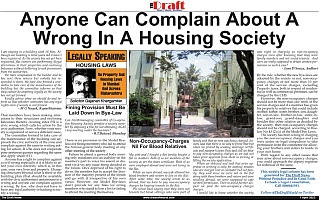Mumbai's Walking Crisis and Misplaced Priorities
By Gajanan Khergamker
The recent account by former journalist and public transport expert Vidyadhar Date walking from Yashwantrao Chavan Centre to Churchgate Station — through the supposedly walkable, heritage-rich precinct of Oval Maidan — ironically after attending a conference on walkability, starkly reveals the hollowness of Mumbai’s “modern infrastructure” narrative.
 |
| A jetty will send the traffic mess at Mumbai's Gateway of India spiraling out of control |
This is not a story unique to South Mumbai or Nariman Point alone. Across the city, we see a fixation with infrastructure that dazzles — coastal roads, sea links, glass-façade stations, multi-level flyovers — but serves little purpose for those not ensconced in cars or air-conditioned transport bubbles. Case in point being a swanky jetty being proposed off the Gateway of India in the midst of a surging traffic imbroglio and corresponding public outrage.
Consider Nariman Point itself — the city’s prestigious business district, symbolic of its post-independence aspirations. Yet, to get from Free Press Journal House to NCPA, one must meander through a labyrinthine route of over a kilometre — a journey that, with pedestrian foresight, could have been a breezy two-minute seaside stroll, as Date maintains.
Walkability — the most basic indicator of urban health — is ignored. Lighting along crucial walking routes is patchy or absent. Footpaths, where they exist, are either illegally occupied, poorly maintained, or an afterthought in urban design. The irony is that officials and corporators think they know better. There's a much-touted awareness of global best practices but knowledge without application is of little value.
Why does this persist? Because Mumbai’s urban planning is vehicle-centric, elitist, and exclusionary. Every new road, flyover, or highway serves the car-owning minority, while the walking majority navigates neglect.
The crux of the issue is this: simple, people-centric solutions — pedestrian pathways, better lighting, small connectors between buildings — do not generate political capital or financial kickbacks. Large infrastructural projects do.
Walkways and paths that enhance walkability cannot be named after politicians. There are no lucrative contracts, no large tenders, no ribbon-cuttings in dimly-lit alleys. Instead, multi-crore projects — however misplaced — offer the twin advantage of visibility and monetisation.
It is telling that the MMRDA (Mumbai Metropolitan Region Development Authority), faced with mounting congestion in Nariman Point, has not considered small-scale pedestrian interventions. Urban planners worldwide are deploying tactical urbanism — creating quick, low-cost, and scalable solutions for walkability. In Mumbai, the very idea of planning remains synonymous with grandiosity.
Predictably, with civic elections looming, political parties rediscover their commitment to pedestrian infrastructure. But such overtures, though welcome, must be read for what they often are: performative gestures aimed at optics rather than substantive transformation.
Unless walkability becomes a non-negotiable metric in Mumbai’s urban planning, the cycle of neglect will continue.
Mumbai’s future does not lie in more concrete but in smarter, human-centric design. Some actionable steps include:
1. Integrated pedestrian networks across commercial districts.
2. Mandatory building-to-building access pathways during new constructions or redevelopment.
3. Night-friendly infrastructure — better lighting, clear signage, active surveillance.
4. De-vehicularising select urban zones to encourage walking and cycling.
5. Transparent urban governance that values long-term quality of life over short-term spectacle.
Ultimately, the city’s tragedy is that it pretends to aspire to the standards of Amsterdam or Singapore while perpetuating the planning of a chaotic, pre-modern town. Until elected representatives treat a citizen walking home with the same respect as a motorist on the Sea Link, Mumbai’s infrastructure story will remain one of missed opportunities and misplaced priorities.
And, the question that persists is: Why Must India’s Greatest City Look Westward for Its Urban Imagination?
There is a question that few urban planners, politicians, or civic commentators in Mumbai dare to ask aloud — and perhaps fewer still want to confront:
Why must Mumbai — with its singular history, social complexity, and lived realities — aspire to become another Singapore or Hong Kong? Why this near-obsessive gaze westward for solutions, templates, and urban models? Why must India’s most powerful metropolis seek legitimacy through mimicry? Why does Mumbai’s imagination of the future so often look like someone else’s past or present?
It is a question deeply rooted not merely in urban policy but in psychology — a post-colonial hangover, an inherited inferiority complex, and a chronic distrust of indigenous knowledge.
Singapore is a well-ordered city-state with a population smaller than some Indian districts. Hong Kong is a former British colony with its own complex history of urban control. Both are admired — often justifiably — for their efficiency, cleanliness, and infrastructure.
But here lies the catch.
Neither of these places remotely resemble Mumbai’s layered, plural, organic chaos. Neither shares Mumbai’s extraordinary density, socio-economic stratification, or cultural multiplicity. Neither faces the challenge of managing electoral democracy on the scale of India’s largest city.
Mumbai is not — and will never be — a controlled urban laboratory. It is a living, breathing, and fiercely democratic organism. To aspire to be Singapore is not just unrealistic — it is unimaginative.



